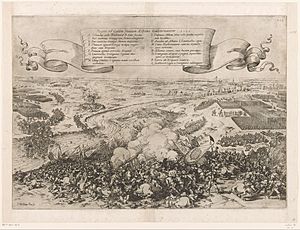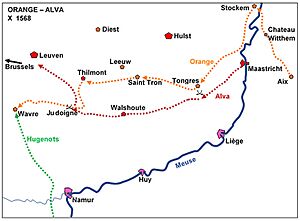Battle of Jodoigne facts for kids
Quick facts for kids Battle of the River Guete or Battle of Jodoigne |
|||||||
|---|---|---|---|---|---|---|---|
| Part of the Dutch Revolt | |||||||
 Engraving of the Battle of the River Guete (Rome, 1632) |
|||||||
|
|||||||
| Belligerents | |||||||
| Commanders and leaders | |||||||
| Duke of Alba | William of Orange | ||||||
| Strength | |||||||
| 16,000 infantry 5,500 cavalry Engaged 2,000 infantry 1,000 cavalry 6 pieces artillery |
21,000 infantry 9,000 cavalry Engaged 2,000 infantry 500 cavalry |
||||||
| Casualties and losses | |||||||
| 80 dead | More than 2,000 dead | ||||||
The Battle of Jodoigne, also known as the Battle of the River Guete, was a fight that happened on October 20, 1568. It was part of the Dutch Revolt, a long war where the Netherlands fought for independence from Spain. In this battle, the Spanish army, led by the Duke of Alba, defeated a rebel army led by William of Orange. This loss forced William of Orange to give up his plans to invade the Spanish Netherlands for a while.
Contents
Why the Battle Happened
In 1568, the Dutch Revolt had turned into a full-scale war, known as the Eighty Years' War. Earlier that year, William of Orange's brothers had fought the Spanish. They won one battle but lost another big one.
Prince William of Orange wanted to do better. He gathered a large army to invade the Spanish Netherlands. However, the Spanish commander, the Duke of Alba, had made sure that cities in the Netherlands were under strict control. This meant William's army would not get much support or supplies from the local people, even those who shared his Protestant beliefs.
The Armies on the Move
Prince William of Orange gathered his army near Aix (now Vaalserberg, a hill). On October 5, his army crossed the Meuse River. The next day, they took control of the town of Stockem. Soon after, the town of Tongres also opened its gates to William's forces.
William's army was quite large, with about 18,000 foot soldiers and 10,000 horse soldiers. Key leaders included William himself and his brother Louis.
Supply Problems for William
A big problem for William was getting enough supplies. The small towns they took over could not feed such a large army. William had hoped to get supplies from Protestant Germany through Liège. But the leader of Liège, Gerard van Groesbeeck, refused to help William. William even tried to demand money from him, but was refused.
Alba's Strategy
On October 7, Alba marched his army from Maastricht. His commanders included his son, Don Fadrique de Toledo. Alba sent troops ahead to strengthen the town of Thilmont.
The two armies had small fights near Tongres on October 9. On October 10, William's army took Saint Tron and took money from its abbey. Alba also made sure that nearby towns sent their soldiers to defend Thilmont.
On October 12, Alba's forces attacked some of William's soldiers who had fallen behind. They killed 600 of William's men and captured many supply wagons. William's army was running out of money to pay its soldiers. This led to a small rebellion among his troops. William himself was almost shot during this time.
William tried to force Alba into a big battle, but Alba avoided it. Alba's main goal was to stop William from getting supplies, not to fight a large battle unless he had a clear advantage.
The Battle Itself
To reach Wavre, Orange had to cross the River Jaulche (also known as the Grote Gete). This river had steep banks, making it hard to cross. To protect his main army while they crossed, William placed a smaller group of soldiers at the back, near Judoigne. This group, led by Colonel Philip van Marbais, had 2,000 foot soldiers and 500 horse soldiers. Their job was to keep the Spanish busy.
Alba attacked this rear-guard very strongly. Even though Alba had a larger army, he only sent a part of it to fight. This group included soldiers led by Vitelli and Alba's son, Fadrique, who brought six cannons.
William of Orange's rear-guard suffered a big defeat. More than 2,000 of his men died. Some important commanders were also lost. Count Hochstrate was badly wounded and died later. Colonel Philip van Marbais was captured, taken to Brussels, and executed.
The Spanish army had very few losses, with only 80 soldiers dying.
What Happened Next
After the battle, Orange met with another group of soldiers he was expecting, but they were much smaller than he hoped. This meant he still didn't have enough men to defeat Alba.
William then tried to find a way back to Germany before winter. He was not allowed to pass through Liège. William's army eventually went through France to Strasbourg, where he paid off most of his soldiers.
Alba punished the towns that had helped William. For example, the leaders of Leeuw were sentenced to death for letting William's brother take over their town. Alba's generals convinced him to change the sentence, so only one of them was executed.
The town of Diest, which belonged to William of Orange, had sent supplies to his army. As punishment, the town had to pay for a Spanish army unit. Later, in 1572, King Philip II of Spain took control of Diest and destroyed its defenses.
See also
 In Spanish: Acción del río Gete para niños
In Spanish: Acción del río Gete para niños


